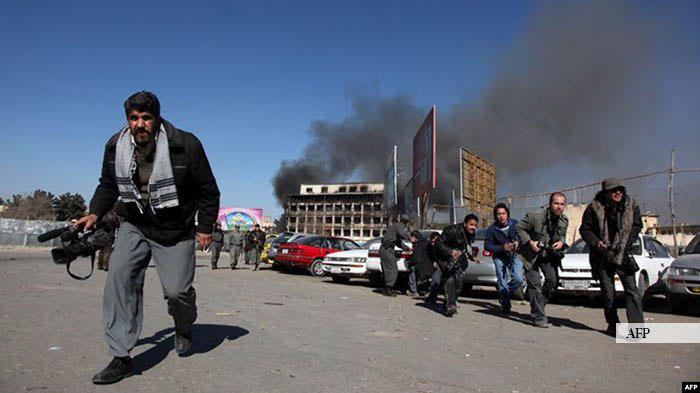Releasing its annual report on December 29, Nai-Supporting Open Media in Afghanistan, said that the violence against journalists and media workers has decreased by 42 percent in 2019 comparing to 2018.
According to the Afghan media watchdog, 198 cases of violence against journalists, including 20 murders, had been recorded in 2018 while the number has dropped to 115 cases of violence, including 10 murder, this year.
The major factor behind this dramatic decrease is, however, reducing live coverage of security incidents, according to executive director of the media watchdog, Abdul Mujib Khalwatgar.
The types of violence in which media workers have become subject to, contains murder, beating, threats and insults, short term arrest, and abduction.
The report further states that 21 media workers have been wounded and in three separate cases media outlets have become under armed attacks.
The same as previous years, financial problems and lack of access to information continue to be the major challenges against media business after the violence.
Speaking at the launch ceremony of the report, Mr. Khalwatgar, said that “fear of uncertainty in the future” is another newly emerged challenge against media business in Afghanistan.
Types and perpetrators of violence
Out of 10 media workers, who have lost their lives, seven have been assassinated, two of them by the Taliban. One journalist was killed in a blast while two media workers were dead in the battles area. “There is a 50 percent decrease in the death toll of the media workers than the past year,” Khalwatgar stated. 20 journalists and media workers were killed in 2018.
Findings by the media watchdog, however, suggest that detention of journalists have increased by 60 percent as compared to the previous year. Afghan government, particularly the National Directorate of Security, have arrested journalists in ten separate cases in Paktia, Khost, and Farah provinces in 2019 for short terms.
Khalwatgar said that one local journalist who was arrested by the NDS weeks earlier is still under custody but the intelligence agency is not providing clarifications on whether his arrest has something to do with his media business or not.
According to the media watchdog, abduction cases have increased by 92 percent as journalists and media workers have been kidnapped and kept in captivity by the Taliban in eight separate cases. The abductions have been happened in Paktia, Farah, and Baghlan provinces.
Afghan journalists have been beaten up by members of Afghan President Protective Service (PPS), police forces, military soldiers, and locals in 10 separate cases during 2019. This figure shows a 31 reduction than the past year. This types of violence was committed by the PPS forces even against some senior media managers, according to the Nai.
The editor-in-chief of 1 TV, Abdullah Khenjani, was beaten up in Zanbaq Square and then briefly detained in April 2019 while he was heading to attend a conference set to be held at the Government Media and Information Center.
Findings of the watchdog reveal that 51 cases of humiliation and insult against journalists have been registered—a slight decrease as comparing to the past year. The Taliban, the PPS security guards, bodyguards of some governors, MPs, police forces, and locals are reported as perpetrators behind this types of violence.
According to the report, media have come under armed attack by unknown men in Nangarhar, Farah, and Ghor provinces in three cases while the number of armed attacks against media outlets was 12 in 2018. This figure shows a 60 percent decline.
Khalwatgar stated some journalists have been illegally summoned by provincial police chiefs of Kapisa and Samangan provinces over the past year.
Challenges in access to information
According to the media watchdog report, lack of access to information is a major challenge against journalists in the country. The challenge has forced journalists in six provinces to register mass complaints. Overwhelmed by the challenge, journalists, at times, have even resorted to boycott governmental institutions in Ghazni province.
Afghan journalists have filed 24 complaints over not being paid and other internal problems within the media organization they work for. According to Nai, the complaints also contain some abusive behavior or illegal conduct with the media workers.
Prosecution of perpetrators
As the report states, the government has relatively acted responsibly to handle 115 registered cases of violence against journalists. “Out of 10 murder cases happened in 2019, perpetrators of five cases have been arrested by the ministry of interior and their dossiers have been sent to attorney general office,” the report indicated, adding that perpetrators of the two cases are currently under police surveillance.
Speaking at the same event, spokesperson for the Attorney General’s Office (AGO), Jamshid Rasooli, said that they have taken legal action regarding 26 cases of violence against journalists in 2019. He added that there were even issued some death sentences by courts regarding the cases of violence against journalists.
Rasooli stated that the AGO has sued and prosecuted a total of 80 cases from past years which also contains 32 cases of murder. “Most of these cases are finalized and have been sent to court,” he added.
The media watch asks Afghan government to call on international courts for suing violence cases committed by the Taliban. It further recommends assigning a special unit for ensuring security of journalists on the battle ground.
Meanwhile, some media activists expressed concerns over increased cyber-attacks on Etilaat-e-Roz’s website after the daily newspaper published investigative reports on corruptions in government organizations. They called on the Ministry of Communication and Information Technology to identify the attackers and prosecute cases of cyber-attacks.




